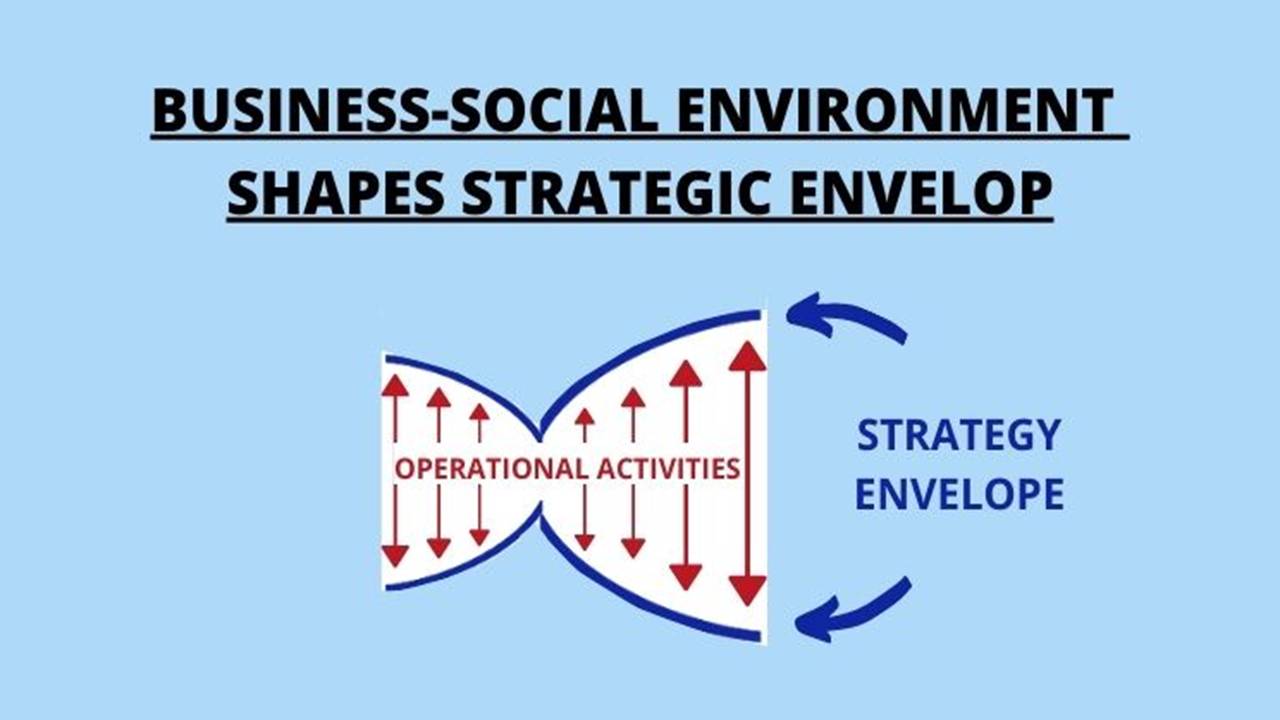by Peter A. Arthur-Smith, Leadership Solutions, Inc.®
“Strategy is about conceptual thinking; operational-activities are about concrete thinking.”

By considering this author’s graphic above: it better explains the distinct differences between both and how they impact each other – where strategy shapes the overall activity flow and operational activities occur within that strategic envelop. The shape of the strategic envelop is fashioned by the dynamics of the surrounding market and societal environment. In other words, your strategy modulates your operational activities. However, without a clear idea of what that envelop looks like, your operational activities are likely to be inadequate and/or disjointed at best. This is probably why so many operational “plans” – management vernacular – end up as a disappointment. One of the biggest mistakes that so many executive-leaders make is mixing strategy and operational activities in a random manner. Often they try to do them simult-aneously, even though it’s virtually impossible to undertake conceptual and analytical thinking at the same time. Too many, unfortunately, don’t fully understand the nature of both functions, consequently miss the opportunity to optimally leverage both. Strategy is typically about tomorrow, whereas operational-thinking is much more about today.
Take the example of a community library: If your library leadership team doesn’t know where it’s going or how it fits-into or serves its local community, its staff could spend untold time spinning its wheels without a great deal to show for it. By not understanding the societal reading tastes or expectations of their local communities, library leaders would have limited ideas about which library areas to expand or shrink. They also wouldn’t have clear ideas about what staff expertise is required to respond to readers’ demands.
Even if they understand these differences, library leaders often don’t know how best to coordinate their strategic and operational activities. Many times they are so well versed in library technology and science that they depend upon that to guide their library strategy, rather than see the bigger marketplace and societal picture to optimally orchestrate library success. Technology and science are only part of the story, whereas the human dimension is a much bigger factor in predicting success. We are sometimes overly impressed with credentials more than human understanding.
Too often those same library leaders mix strategic and operational features in a haphazard way and therefore find their domain is treading water. Also, their limited people-leadership capability and sensitivities at times put them at a performance disadvantage. So the question is: How do they best co-ordinate strategy and staff operational-activities to maximum library advantage?
This question pops-up in almost any organization’s life. It’s virtually impossible to orchestrate strategy and operational activities simultaneously without reducing clarity of thought or veering off in the wrong direction – usually due to some expedient thought or action. To that end, for library leaders and their immediate teams, and depending on the scale of their library operation, they should break their strategy-operational activities into appropriate time spans. The below pictograph shows four potential library leader roles and then depicts their proposed focus to balance strategic and operational activities. It breaks their focus down into tomorrow and today time-spans.

With this schematic, you can envisage the appropriate library leader focusing on the right degree of tomorrow-time on a regular basis to think through/envision their library journey and map-out/position the resources/activities that will be required during their next 1-3 years, 1 year or next quarter. These are vital, habitual disciplines required at each level. Wherever possible you should include your immediate team to gain their insights and overall buy-in.
(NOTE: The exception would be if a large conceptual gulf exists between your team and yourself, when it comes to strategic issues. If so, a reasonable amount of time should be devoted to educating that team. If that doesn’t produce the desired results, then members should gradually be replaced in a respectful manner.)
Once the strategic shape, intentions and resources are set, within the appropriate time-span window, then the corresponding operational activities can be articulated to fit within your strategic envelop. Now you and your library team are much better equipped to pursue and execute your journey, its milestones and operational initiatives…they can be labeled A, B, C, D etc and executed accordingly. We recommend that these are taken-on by “pairs” of your team, since pairs are the optimal size team to make things happen – also that you aim to restrict the number of initiatives that you focus on at any one time; preferably three. (NOTE: As much as is possible, “pair members” should be complementary to each other in personality and skill terms; since, when people are too much alike, they are usually not especially creative.)
Initially, this sounds like a real challenge. But, in the same way that you learned to drive a car, with one foot on the brake and the other on the accelerator, you discovered an optimum approach to holding your driving speed over a reasonable period of time. Strategy and operational-activities are much the same, except that instead of using your feet you will use your head. Over time, as with learning to drive, your approach to optimizing strategy and operational-activities become fairly automatic. From such behavior, your library staff will begin admiring and effectively responding to your leadership approach. You won’t regret the effort and neither will your team!
To learn more about building momentum, talk with:
